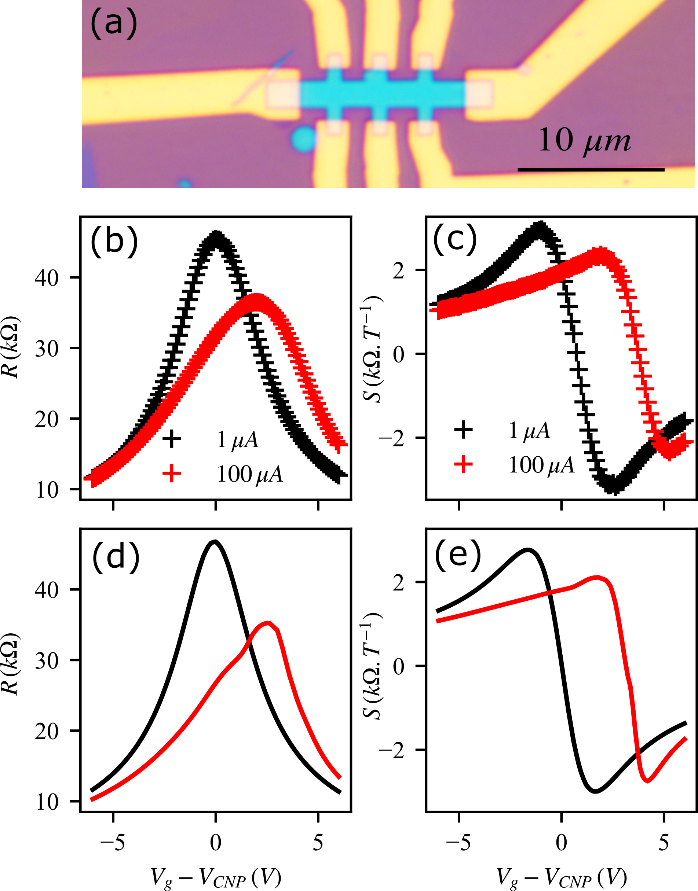Laboratory : LPCNO, Nanomagnetisme group, INSA Toulouse
Supervisors : Benjamin Lassagne, Thomas Blon
Contacts : lassagne@insa-toulouse.fr, thomas.blon@insa-toulouse.fr
Tel : 05 61 55 96 70
Keywords : graphene, magnetic field sensors, Hall effect, 2D materials, van der Waals heterostructures.
Graphene is a material with a monoatomic thickness, composed solely of sp2-hybridized carbons, and exhibiting extraordinary properties including a purely 2D electronic structure, zero effective mass, record electron mobility of 180,000 cm²/V/s at room temperature, electron density that can be easily modulated with an electrostatic grid, and very high mechanical strength. Since its discovery in 2004 [1], graphene has been the focus of much interest in the scientific community, which is considering its use in a wide range of innovative applications in nanoelectronics [2], metrology [3], optoelectronics [4], magnetometry [5] and the study of exotic superconductors [6].
The Nanomagnetism group at LPCNO specializes in the study of the galvanomagnetic properties of graphene, with the ultimate aim of fabricating ultra-sensitive Hall-effect magnetic sensors based on boron nitride/graphene/boron nitride(hBN) heterostructures. The team has recently developed a comprehensive and novel model for the detailed understanding of the operation of graphene Hall-effect sensors, which has enabled it to significantly improve their performance [7].

|
Figure. (a) hBN/graphene/hBN Hall sensor fabricated at LPCNO. (b) and (c) Experimental resistance R and magnetic field sensitivity S of the graphene Hall sensor at room temperature under 100 mT and for two values of the bias current. (d) and (e) Corresponding simulated R and S using the developed model. From [7].
|
The group now focuses on using these graphene Hall-effect sensors to measure the static and dynamic magnetic properties of nanometer-sized ferromagnetic (FM) systems. The first area concerns the measurement, particularly at cryogenic temperatures, of highly promising 2D van der Waals FM materials such as CrI3, CrBr3, Cr2Ge2Te6 or FexGeTey [8], with the perspective of producing graphene/2D FM material spin heterostructures [9]. The second axis concerns the detection of high-frequency magnetic excitations in ferromagnetic dots and spin-wave propagation lines. Proof-of-concept of such detection could lift the technological bottleneck on nanoscale spin-wave detection and pave the way for magnonic devices [10].
The proposed internship concerns (i) the fabrication and characterization of Hall-effect sensors, (ii) the measurement of the magnetic properties of ferromagnetic 2D materials in hBN/graphene/hBN/2D FM/hBN heterostructures, and/or the detection of ferromagnetic resonance in magnetic dots covered with a hBN/graphene/hBN heterostructure (collaboration with CEMESCNRS Toulouse). Remuneration: 567 € per month. This internship can be continued as a thesis, subject to funding being obtained.
Profile student:
We look for a master 2 or engineer school student specialized in condensed matter physics or nanophysics. The student must have aptitude for experimental physics and multidisciplinary. He/she must be meticulous, organised and must show initiative and independence.
Bibliography
|
[1] K.S. Novoselov et al, Science, 306, 666 (2004) [2] F. Schwierz et al, Nat. Nano., 5, 487 (2010) [3] K.S. Novoselov et al, Nature, 438, 04233 (2005) [4] W. Zhang et al, Sci. Rep., 4, 3826 (2014) [5] B. Shaeffer et al, Nat. Comm., 11, 4163, (2020) |
[6] J. M. Park et al, Nature, 590, 249 (2021) [7] L. Petit et al, NanoExpess, under review (2023) [8] C. Gong et al, Nature, 546, 265 (2017) [9] T. Song et al, Science, 360, 1214 (2018) [10] A. Chumak et al, Nat Com., 5, 4700 (2014) |